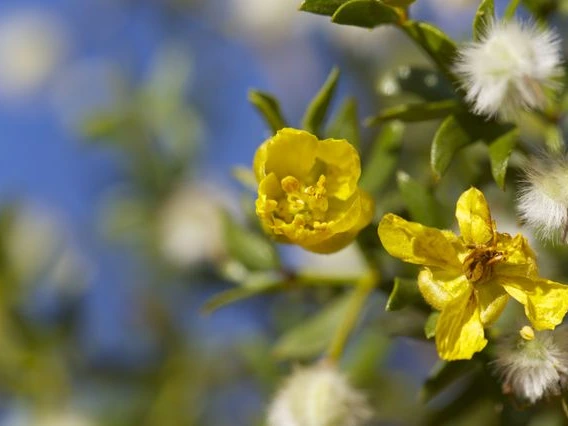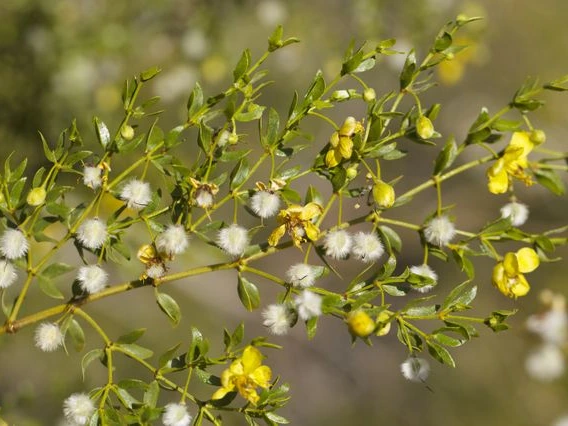


Botanical Name: Larrea tridentata
Common Names:
English: Creosote bush
Spanish: Hediondilla
O'odham: Ṣegai
Family: Zygophyllaceae
Rain Garden Zone: L. tridentata thrives in the top Rain Garden Zone, although it may also grow well in the terrace Rain Garden Zone.

Reproduced with permission from "Rainwater Harvesting for Drylands and Beyond" by Brad Lancaster, HarvestingRainwater.com
Flowering Season: April--May, Monsoon
Harvest Season: April--May, Monsoon
Harvest Techniques: Harvest creosote leaves and/or flowers after rain, when the resins are most abundant.
Planting Season: Spring, Fall (5)
Characteristics: L. tridentata is an everygreen shrub reaching a maximum height of 10', though more commonly within 3-5' in height. The leaflets are dull, olive green and coated with a sticky, aromatic resin which releases a strong perfume followint rainstorms. The flowers are small and yellow with 5 petals, appearing most abundantly in the spring and following summer rains. The fruit of L. tridentata is a small, round, and fuzzy white capsule with 5 tiny carpels containing 1 seed. Creosote bush is extremely drought tolerant, and produces sugars needed for growth well into drought, making them quick to flush out after the infrequent rainfall characteristic of its growth range.
Landscape Cultivation: The impermeable seed coating delays germination until sufficient moisture is present. To speed up germination for landscape cultivation, the seeds must be hulled. A mechanical huller may be used for large amounts of seeds, or individual seeds may be filed down on one side with sandpaper. L tridentata is extremely drought tolerant and requires very little watering once established.
Ecology: The foliage of L. tridentata acts as protection for select species of grasshoppers, praying mantids, and crickets which rely solely on this plant.
Ethnobotany
Food:
Creosote bush has traditionally been taken orally through teas and tinctures to treat a variety of ailmets. See "Other" below for a full range of medicinal uses.
Domestic Animals:
Creosote bush in its natural form is toxic to many livestock animals, and it is not considered suitable for livestock feed.
Other:
Creosote bush has traditionally been used medicinally, in moderation, to treat a wide ranfe of ailments, including the common cold, digestive issues, fevers, ulcers, and nausea (1). Creosote can also be applied externally to treat muscle pain, as well as skin conditions ranging from acne to fungal infections (5). The chemical properties of the plant yield it an effective antimicrobial and antiviral treatment (7) making it effective for wound healing, cold sores, and bacterial infections (6). The resinous incrustation commonly found on the branches has traditonally been used to mend pottery, fix arrow points, and make pottery.
References:
- Phillips, Steven J. and Comus, Patricia Wentworth. A Natural History of the Sonoran Desert. Tucson: Arizona-Sonora Desert Museum Press, 2000. Print.
- https://www.utep.edu/herbal-safety/herbal-facts/herbal%20facts%20sheet/creosote-bush-chaparral.html
- https://ucsdnews.ucsd.edu/pressrelease/compounds_in_desert_creosote_bush_could_treat_giardia_and_brain_eating_amoe
- Lancaster, B. (2006) Rainwater harvesting for drylands and beyond. Tucson, AZ. RainSource Press.
- https://www.fs.fed.us/database/feis/plants/shrub/lartri/all.html
- https://wa.kaiserpermanente.org/kbase/topic.jhtml?docId=hn-2067001
- https://ucsdnews.ucsd.edu/pressrelease/compounds_in_desert_creosote_bush_could_treat_giardia_and_brain_eating_amoe
- https://www.laspilitas.com/nature-of-california/plants/374--larrea-trid…
For more information on this plant, see the Campus Arboretum species descriptions.
Go to the next tour stop: wolfberry page or Return to the main Dunbar Spring tour page

